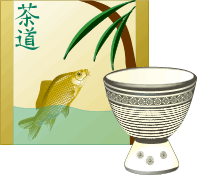A Brief History
Discover the ancient origins and fascinating history of tea!
Tea is one of the most popular drinks in Japan and a tea ceremony is a very important and special event. It is a time to relax and enjoy the loveliness of the simple things around you. There are two types of tea ceremony - the Chanoyu, sometimes called the Matcha, and the Sencha. The word 'chanoyu' means 'hot water for tea'.
The Chanoyu ceremony takes place in a wooden or bamboo teahouse called a Chashitsu. There is usually room for four guests. The garden around the teahouse is very simple with lots of green plants rather than flowers, a small rock garden, and a stream. A path winds its way through the garden leading to the teahouse. If you are invited to a Chanoyu tea ceremony there are certain rules to follow.
 First you must wait at the entrance to the garden until you are calm and ready to enter. The Teishu or tea master welcomes you when you are in the garden. He or she brings fresh water for you drink and to wash your hands. Now you follow the Teishu along the path to the teahouse.
First you must wait at the entrance to the garden until you are calm and ready to enter. The Teishu or tea master welcomes you when you are in the garden. He or she brings fresh water for you drink and to wash your hands. Now you follow the Teishu along the path to the teahouse.
Inside the teahouse, the Teishu makes the tea using powdered green tea called 'matcha'. The tea is mixed with boiled water using a bamboo whisk and served in small bowls.
Guests sit on the floor around a low table. When the Teishu gives you your tea, bow, take your bowl with your left hand, and then hold it with your right hand. Place the bowl in front of you and turn it to the right so that you don't drink from the side that was facing you. Usually the Teishu gives you a sweet cake or a mochi to eat as well because the tea is bitter.
When you have finished your tea turn the bowl to the left and place it on the table in front of you - you must drink it all! You turn the bowl to show the Teishu respect: it means that the edge of the cup he gave you was the best, but you are not good enough to drink from that side. Sometimes the guests share one bowl that they pass around.
The Sencha ceremony, is more relaxed than the Chanoyu ceremony. The rules for serving the tea are traditional but the occasion is more easy-going for the tea drinkers.
Most people in Japan don't have their own teahouse but they often belong to a 'tea club' where they go every week to take part in the tea ceremony.